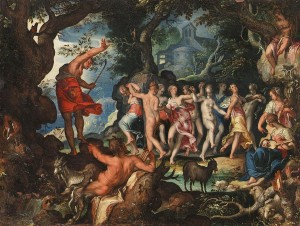
The Apulian Shepherd depicts a poem from the narrative of Ovid’s Metamorphoses (14.512-527).
Metamorphoses 14.512-527 tells the story of a shepherd who stumbles upon the twelve nymph companions of the Greek God Pan while in the woods. The nymphs were scared off momentarily by an Apulian Shepherd but later returned after realizing the shepherd could be ignored. Once the nymphs start dancing the shepherd mimics, mocks and insults them. He conunties this until he is finally turned into an oleaster tree, where one can still taste his bitter words through the berries tartness. The moral behind the mythological story for the reader is not to mock the gods personally or their companions, which would be the nymphs in this case because they in a sense choose your destiny.
Joachim Wtewael’s The Apulian Shepherd is the earliest painting in the Small Treasures exhibition. The vibrant and brightly colored mythological painting was produced in the Netherlands during the Baroque period. Wtewael’s was originally a draughtsman who trained in his father’s glasswork shop in Utrecht. Wtewael’s career lasted from1590, earliest known dated piece, to 1628, his latest known dated piece. During the early years of his career, 1588-1592, Wtewael spent time in Italy and France under the patron Charles de Bourgneuf. Wtewael was one of the last practitioners of the mannerist style in the northern Netherlands, who predomintaly painted Biblical and mythological paintings. He was known for combing the two approaches of uyt den geets, from the imagination, and naer’t leven, “after life”.
Annotated Bibliography
http://smalltreasures.as.ua.edu/annotated-bibliography-4/
By Taylor McNeil